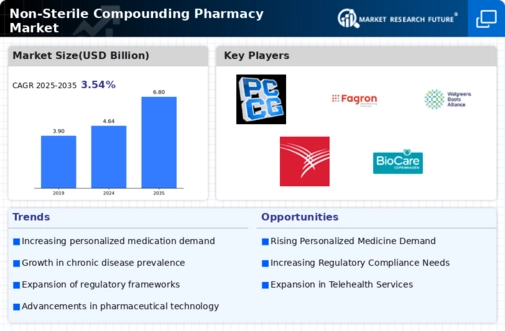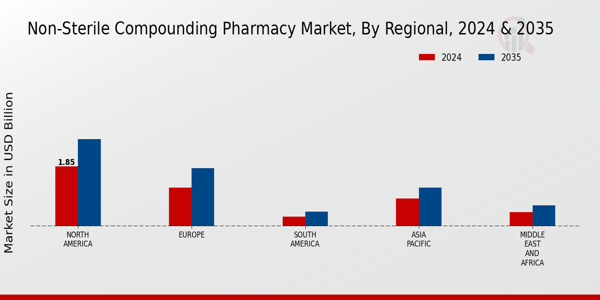Market Growth Projections
The Global Non-Sterile Compounding Pharmacy Market Industry is projected to experience substantial growth over the coming years. With an estimated market value of 4.64 USD Billion in 2024, the industry is anticipated to reach 6.8 USD Billion by 2035. This growth trajectory suggests a robust compound annual growth rate (CAGR) of 3.54% from 2025 to 2035. Such projections indicate a favorable environment for compounding pharmacies, driven by increasing demand for personalized medications, advancements in technology, and supportive regulatory frameworks.
Advancements in Pharmaceutical Technology
Technological advancements play a crucial role in shaping the Global Non-Sterile Compounding Pharmacy Market Industry. Innovations in compounding techniques and equipment have improved the efficiency and safety of medication preparation. For instance, the adoption of automated compounding devices enhances precision and reduces the risk of human error. Furthermore, the integration of software solutions for inventory management and prescription processing streamlines operations. As these technologies continue to evolve, they are likely to drive growth in the market, which is expected to expand at a CAGR of 3.54% from 2025 to 2035.
Increasing Prevalence of Chronic Diseases
The Global Non-Sterile Compounding Pharmacy Market Industry is significantly influenced by the rising prevalence of chronic diseases. Conditions such as diabetes, hypertension, and arthritis require ongoing management, often necessitating customized medications. Compounding pharmacies are well-positioned to address these needs by providing formulations that may not be commercially available. This trend is expected to contribute to the market's growth, with projections indicating a rise to 6.8 USD Billion by 2035. The ability to create specific dosages and combinations tailored to individual patient requirements enhances treatment efficacy and patient satisfaction.
Rising Demand for Personalized Medications
The Global Non-Sterile Compounding Pharmacy Market Industry experiences a notable increase in demand for personalized medications. As healthcare becomes more patient-centric, the need for tailored therapies grows. Compounding pharmacies can create customized formulations that meet specific patient needs, such as unique dosages or alternative delivery methods. This trend is particularly evident in the treatment of chronic conditions, where individualized therapies can enhance patient compliance and outcomes. The market is projected to reach 4.64 USD Billion in 2024, reflecting the increasing reliance on compounding pharmacies to provide specialized medications.
Regulatory Support for Compounding Practices
Regulatory frameworks are evolving to support the Global Non-Sterile Compounding Pharmacy Market Industry. Government agencies are recognizing the importance of compounding pharmacies in providing essential medications, particularly for patients with unique needs. Initiatives aimed at streamlining regulations and ensuring quality standards are likely to bolster the market. For instance, the implementation of guidelines that promote best practices in compounding can enhance safety and efficacy, thereby increasing consumer trust. As regulations become more favorable, compounding pharmacies may experience growth opportunities, further solidifying their role in the healthcare system.
Growing Awareness of Compounding Pharmacy Benefits
There is a growing awareness among healthcare providers and patients regarding the benefits of compounding pharmacies within the Global Non-Sterile Compounding Pharmacy Market Industry. Educational initiatives and outreach programs are helping to inform stakeholders about the advantages of customized medications, such as improved adherence and reduced side effects. As more healthcare professionals recognize the value of compounding in patient care, the demand for these services is likely to increase. This heightened awareness may contribute to the market's expansion, as patients seek personalized solutions for their healthcare needs.







